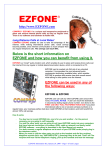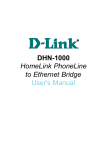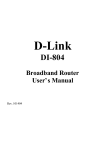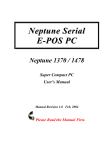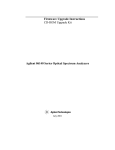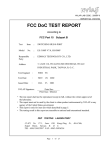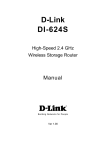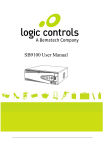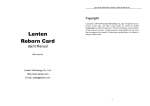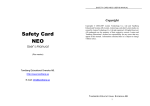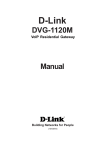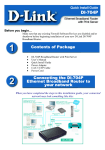Download D-Link DI-714 User's Manual
Transcript
D-Link DI-714 Wireless Broadband Router User’s Manual Rev. 020205F Contents Introduction ................................................................................................5 Package Contents .....................................................................................6 Introduction to Broadband Router Technology........................................7 Introduction to Firewalls ..........................................................................7 Introduction to Local Area Networking ...................................................8 Introduction to Virtual Private Networking..............................................9 Introduction to Wireless Networking .....................................................10 Hardware Installation ..............................................................................12 Placement ...............................................................................................12 Safety Precautions ..................................................................................12 Front Panel .............................................................................................13 Dial-Up ...............................................................................................13 Wireless ..............................................................................................13 Local Ethernet ....................................................................................13 Rear Panel...............................................................................................13 DIAL-UP MODEM............................................................................13 Basic DI-714 Configuration & Main Page .............................................14 Start-up and Log in.................................................................................14 Main Page...............................................................................................16 Setup Wizard ..........................................................................................16 Time Settings......................................................................................17 Device IP Settings ..............................................................................18 Cable/DSL ISP Settings .....................................................................19 ISP Additional Settings ......................................................................20 Modem Settings..................................................................................22 Device Information.................................................................................23 2 Device Status..........................................................................................24 Basic Setup .............................................................................................25 Advanced Settings ....................................................................................27 DHCP Server Settings ............................................................................27 Virtual Server Settings............................................................................28 DMZ ...................................................................................................29 Static Routing .........................................................................................30 Dynamic Settings ...................................................................................31 Modem String Settings...........................................................................32 Password Settings...................................................................................33 System Tools..............................................................................................34 Intruder Detection Log ...........................................................................34 Display Routing Table............................................................................35 System Diagnostics ................................................................................37 Load Default Settings.............................................................................38 Upgrade Firmware..................................................................................39 Reset Device...........................................................................................40 Troubleshooting ........................................................................................41 Basic Functions ......................................................................................41 LAN Connection Problems ....................................................................43 ISP Connection Problems.......................................................................45 Internet Application Problems................................................................46 Wireless Troubleshooting.......................................................................47 Performing a Factory Reset....................................................................48 Using the PING Utility in Windows 95/98/Me......................................49 Using the WINIPCFG Utility in Windows 95/98/Me ............................51 Technical Specifications ...........................................................................53 Contacting Technical Support.................................................................54 Limited Warranty.....................................................................................55 3 Registration............................................................................................58 4 Introduction Congratulations on your purchase of the D-Link Wireless Broadband Router. Your Wireless Broadband Router enables you to share your DSL or Cable Internet connection with computers on your network. This guide will explain the features and functions of the Wireless Broadband Router to help you get the most out of your Internet experience. D-Link’s DI-714 allows LAN users to share a single Internet Connection while providing the safety and security of port blocking, packet filtering, and a natural firewall. Static address support, integrated DHCP, PPPoE, and device name support will allow it to connect to nearly any broadband provider whether Cable or DSL based, and at the same time simplify local area network settings. The DI-714 provides two levels of security support. First, it masks local users’ IP addresses from others on the Internet making it much more difficult for a hacker to target a machine on your network. Secondly, it can block and redirect certain ports to limit the services that outside users can access. Specific ports can be opened to ensure that games and other Internet applications will run properly. The Wireless Broadband Router provides special pass-through support for common VPN implementations. The Virtual Server feature allows you to expose HTTP, FTP, Game Servers and other local services to be accessible to Internet users located outside of the LAN. The User-Definable Application Sensing Tunnel feature allows you to define the attributes to support special applications requiring multiple connections, such as Internet gaming, video conferencing, and Internet telephony. A DMZ setting can be applied to a single client behind the Wireless 5 Broadband Router to expose it to the Internet and ensure complete Internet application compatibility even if specific ports are not known. Unlike proxy server or NAT software that requires the software server to remain visible on the Internet, local networked computers are not directly externally visible when using the DI-714. Also the Wireless Broadband Router, like broadband, is always on, removing the need to constantly boot a software server when access is desired from a client. Integrated DHCP services allow up to 253 users to get their IP address automatically on boot up from the DI-714. Client machines require no software (only the installed NIC card in a wireless network), simply set the Ethernet or wireless adapters to accept a dynamically assigned IP address and reboot. Each time they are powered up the DI-714 will recognize them and set their IP address to instantly connect them to the LAN. Package Contents The D-Link DI-714 package should include the following items. DI-714 Wireless Broadband router User’s Manual Quick Install Guide Power Adapter CAT-5 UTP Cable 6 Introduction to Broadband Router Technology A router is a device that forwards data packets from a source to a destination. Routers work on the OSI (Open System Interconnection) Layer 3, which forwards data packets using IP addresses and not a MAC (Media Access Control) address. A router will forward data from the Internet to a particular computer on your LAN. The information that makes up the Internet gets moved around using routers. When you click on a link on a web page, you send a request to a server to show you the next page. The information that is sent and received from your computer is moved from your computer to the server using routers. A router also determines the best route that your information should follow to ensure that the information is delivered properly. A router controls the amount of data that is sent through your network by eliminating information that should not be there. This provides security for the computers behind your router because computers from the outside cannot access or send information directly to any computer on your network. The router determines which computer the information should be forwarded to and sends it. If the information is not intended for any computer on your network, the data is discarded. This keeps any unwanted or harmful information from accessing or damaging your network. Introduction to Firewalls A firewall is a device that sits between your computer and the Internet that prevents unauthorized access to or from your network. A firewall can be a computer using firewall software or a special piece of hardware 7 built specifically to act as a firewall. In most circumstances, a firewall is used to prevent unauthorized Internet users from accessing private networks such as corporate LAN’s and Intranets. A firewall watches all of the information moving to and from your network and analyzes each piece of data. Each piece of data is checked against a set of criteria that the administrator configures. If any data does not meet the criteria, that data is blocked and discarded. If the data meets the criteria, the data is passed through. This method is called packet filtering. A firewall can also run specific security functions based on the type of application or type of port that is being used. For example, a firewall can be configured to work with an FTP or Telnet server. Or a firewall can be configured to work with specific UDP or TCP ports to allow certain applications or games to work properly over the Internet. Introduction to Local Area Networking Local Area Networking (LAN) is the term used when connecting several computers together over a small area such as a building or group of buildings. LAN’s can be connected over a large area. A collection of LAN’s connected over a large area is called a Wide Area Network (WAN). A LAN consists of multiple computers connected to each other. There are many types of media that can connect computers together. The most common media is CAT5 (Ethernet) cable; UTP or STP twisted pair wire. On the other hand, wireless networks do not use wires; instead they communicate over radio waves. Each computer must have a Network Interface Card (NIC), which communicates the data between computers. A NIC is usually a 10Mbps network card, or 10/100Mbps network card, or 8 a wireless network card. Most networks use hardware devices such as hubs or switches that each cable can be connected to in order to continue the connection between computers. A hub simply takes any data arriving through each port and forwards the data to all other ports. A switch is more sophisticated, in that a switch can determine the destination port for a specific piece of data. A switch minimizes network traffic overhead and speeds up the communication over a network. Networks take some time in order to plan and implement correctly. There are many types of scenarios to consider which could affect the operability of a network. Introduction to Virtual Private Networking Virtual Private Networking (VPN) uses a publicly wired network (the Internet) to securely connect two different networks as if they were the same network. For example, an employee can access the corporate network from home using VPN, allowing the employee to access files and printers. Here are several different implementations of VPN that can be used. Point-to-Point Tunneling Protocol (PPTP) PPTP uses proprietary means of connecting two private networks over the Internet. PPTP is a way of securing the information that is communicated between networks. PPTP secures information by encrypting the data inside of a data packet. 9 IP Security (IPSec) IPSec provides a more secure network-to-network connection across the Internet or a Wide Area Network (WAN). IPSec encrypts all communication between the client and server whereas PPTP only encrypts the data packets. Both of these VPN implementations are used because there is not a standard for VPN server software. Because of this, each ISP or business can implement its own VPN network making interoperability a challenge. Introduction to Wireless Networking D-Link wireless products are based on industry standards to provide easy- to- use and compatible high-speed wireless connectivity within your home or business. Strictly adhering to IEEE 802.11b the D-Link Air wireless family of products will allow you to access the data you want, when and where you want it. No longer will you be tethered to a workstation or forced to run new wiring. You will be able to enjoy the freedom that wireless networking delivers. Standards Based Technology Based on IEEE 802.11b, D-Link Air wireless products can throughput data up to 11 Megabits per second.* This means you will be able to transfer large files quickly or even watch a movie in MPEG format over your network without noticeable delays. This technology works by using multiple frequencies in the 2.4GHz range utilizing Direct Sequence Spread Spectrum (DSSS) technology. D-Link Air products will automatically sense the best possible connection speed to ensure the greatest speed and range possible with the technology. *Maximum wireless signal rate based on IEEE Standard 802.11b specifications. Actual data throughput will vary. Network conditions and environmental factors, including volume of network traffic, building materials and construction, and network overhead lower actual data throughput rate. 10 Installation Considerations Designed to go up to 300 feet indoors and up to 900 feet outdoors, D-Link Air lets you access your network from virtually anywhere you want. Keep in mind, however, that the number of walls, ceilings or other objects that the wireless signals must pass thru will limit range. Typical ranges vary depending on the types of materials and background RF noise may be evident in your home or business. The key to maximizing range is to follow these basic principles: 1. Keep the number of walls and ceilings to a minimum - Each wall or ceiling can reduce your D-Link Air Wireless products range from 3-90 feet. Position your Access Points(base stations in a wireless network), Routers, and Computers so that the number of walls or ceilings is minimized. 2. Be aware of the direct line between Access Points, Wireless Broadband Routers, and Computers - A wall that is 1 foot thick, at a 45 degree angle appears to be almost 3 feet thick. At a 2 degree angle it looks over 42 feet thick! Try to make sure that the AP and Adapters are positioned so that the signal will travel straight through a wall or ceiling for better reception. 3. Building Materials make a difference - A solid metal door or aluminum studs may have a negative effect on range. Again, try to position Access Points, Routers, and Computers so that the signal passes through drywall or open doorways and not other materials. 4. Make sure that the antenna is positioned for best reception by using the software signal strength tools included with your product. 5. Keep your product at least 3-6 feet away from electrical devices that generate RF noise, like microwaves, Monitors, electric motors, etc. 11 For the average American multiple bedroom home, range should not be a problem. If you experience low or no signal strength in areas of your home that you wish to access, consider positioning the Access Point in a location directly between the Routers and/or Computers that will be connected. Additional Access Points can be connected to provide better coverage in rooms where the signal does not appear as strong as desired. Hardware Installation Placement The DI-714 Wireless Broadband Router should be placed in a safe and secure location. To ensure proper operation, please keep the unit away from water and other damaging elements. Safety Precautions Please read the installation guide thoroughly before you install the DI-714. The DI-714 should only be repaired by authorized and qualified personnel. Please do not try to open or repair the DI-714 yourself. Opening the device will violate the products warranty. Do not place the DI-714 in a damp or humid location, e.g. a bathroom. The DI-714 should be placed in a sheltered and non-slip location within a temperature range of 41 to 104 degrees Fahrenheit. Please keep the plastic bag of the DI-714 and the clip binding the cable out of reach of children and babies to avoid choking. Please do not expose the DI-714 to direct sunlight or other heat sources. The device’s housing and internal electronic components may be damaged by direct sunlight or heat sources. 12 Front Panel The front panel provides LED lights to indicate the status of the unit. Refer to the following table for the meaning of each LED feature. Power status of the DI-714. A steady LED indicates that Power the power is “on.” No LED light indicates lack of power. Router status indicator. When the router starts up, the Status Status LED will briefly blink. If the unit is defective, then the indicator will be constantly “on.” Broadband Wide Area Network status. When connected to the Cable/DSL modem, the LED indicator light is “on.” Indicates Dial-Up modem status. When modem connection Dial-Up is established then the LED indicator light is “on.” Indicates the status of the Wireless Access Point (AP.) When Wireless the Wireless AP is ready, the LED indicator is “on.” Indicates link and activity of each Local Ethernet port. Local When a device (computer, hub or switch) is connected to Ethernet one of the Ethernet ports, the LED indicator is “on.” During 1234 (Link/Act) data transfer, the LED indicator light is “blinking.” Rear Panel The rear panel features the Local Ethernet ports, Broadband port, Dial-up Modem port and Factory Reset button. Refer to the following table for the meaning of each feature. Used to connect to the power outlet. Only use the power POWER adapter provided with the DI-714. Use of an unauthorized power adapter may cause damage to your 5V / DC device and violate your warranty. BROADBAND The RJ-45 Ethernet port labeled “Broadband” is used to connect your DI-714 to your DSL or Cable modem. Port used to connect an external backup modem. DIAL-UP MODEM Resets the configuration to default factory settings. RESET 13 Local Ethernet The Ethernet ports used to connect devices capable of Ethernet connection such as a computer, hub, or switch. 1 2 3 4 The Ethernet Ports will automatically detect a straight-through or crossover cable. Basic DI-714 Configuration & Main Page The DI-714 provides a Web Configuration interface that can be accessed using standard web browsers such as Netscape Communicator or Microsoft Internet Explorer. Since the interface is web based (HTTP), the DI-714 can be configured with any Java and HTML compliant Internet browser in any operating system. This section will discuss the Web Configuration interface and how to use different options and settings. Although you can change the IP address of the DI-714 to meet your needs, this manual will assume that the defaults are left in place. This means that the IP address of your DI-714 will be 192.168.0.1. If you have changed the IP address scheme, please substitute 192.168.0.1 with the IP address scheme that you have chosen. Start-up and Log in In order to configure the DI-714, you must use your web browser and manually input 192.168.0.1 into the Address box and press Enter. The Main Page will appear. The Device Information and Device Status screens can be seen without logging into the DI-714. However, when the Setup Wizard, Basic Setup, Advanced Settings and System Tools buttons are pressed, the log in screen will be shown. 14 In order to configure the DI-714 you must input the user-name into the User Name box. Enter the password into the Password box and press the OK button. The default User Name is “admin.” There is no default password, leave the Password field blank. Once you have logged-in as administrator, it is a good idea to change the administrator password to ensure a secure connection to the DI-714. The Advanced Settings section described later in this manual describes how to change the password. Once you have input the correct password and logged-in, the screen will change to the Main Page screen. If you are having problems logging in and you are sure that the password you are using is correct, check the top right-hand corner of your keyboard to make sure that the Caps Lock light is not on. 15 Main Page The Main Page screen provides links to the main sections of the web configuration interface. Setup Wizard The Setup Wizard is a step-by-step guide to configuring the DI-714 to work with your ISP provider. Please refer to the Quick Install Guide for additional instructions. 16 Time Settings Please choose the local time zone. After selecting the correct time zone, click on the Next button to continue. You can also click the buttons on the left hand side to reach a specific setting in the configuration. 17 Device IP Settings You have to give your Internet gateway an IP address on your “private” network. This is not the “public” IP address from your ISP but the local internal LAN IP address. The IP address of “192.168.0.1” is the default IP address of the LAN port in the broadband router. Device IP Address The internal LAN IP address of the broadband router. Device IP Subnet Mask The subnet mask can usually be left with the default entry of “255.255.255.0” 18 Cable/DSL ISP Settings The DSL/Cable ISP settings have a default to obtain dynamically the IP address for the WAN port of the broadband router. Some ISPs may give you Static IP settings. If this is the case for your ISP then you need to: Enter the IP address that is assigned by your ISP Enter the IP subnet mask Enter the ISP gateway address Enter the DNS IP address 19 ISP Additional Settings If you would like to use ISP additional settings you have to enable this function and configure this page. Some ISPs use this protocol for authentication purposes; if this is the case, you need to enter: User name: Enter the user name of your ISP account. Password: Enter the password of your ISP account. Retype password: Enter the password of your ISP account again to re-confirm. 20 Some ISPs, especially cable modem providers, use the “Host Name” to authenticate the user. If this is the case, you will need to enter: Host Name: Enter the host name provided by the ISP. Some ISPs require the user to input the MAC address of the original Ethernet adapter. If this is the case, enter: MAC Address: Enter the MAC address of the Ethernet adapter. NOTE ! Some ISPs may recognize your LAN card MAC address as a legal user; In this case, you have to copy the LAN card MAC address in the MAC address field. For WIN 95/98 you can run winipcfg to see the LAN card MAC address For WIN 2000/NT you can run ipconfig /all to see the LAN card MAC address 21 Modem Settings An analog external modem can be used as a dialup backup to the DSL/Cable connection. If you would like to use a modem backup, you need to enable the modem settings function. Click on “Modem Settings” on the left hand side and input the ISP account settings. Note: If you change the baud rate settings, please check the initial string. (Please refer to the modem’s manual.) 22 Device Information The Device Information screen displays the basic information of your DI-714. The Device Name is the same as the Computer Name that was set in the Setup Wizard. The IP Address is the IP Address assigned to LAN side of your DI-714. The Private LAN MAC Address the MAC Address assigned to the LAN side of your DI-714. The Public WAN (Cable/DSL) MAC Address is the MAC Address assigned to the WAN port of the DI-714. This MAC Address may be used by some cable modem connections. The Firmware Version is the current firmware version used by the DI-714. 23 Device Status The Device Status screen displays a graphical representation of your current configuration. The left side of the screen shows your connection information in regards to WAN and LAN IP Address information. The right side displays the connection status of each device. This means that there is a connection. This means that there is not a connection. 24 The DHCP Log displays information about each IP Address assigned to a computer using the DHCP server built-in to the DI-714. Basic Setup The Basic Setup screen enables you to change basic settings related to accessing the Internet. All of the settings covered in the Basic Setup section are covered in the Setup Wizard. The Computer Name is used to give a name to your connection if you are using a Cable modem. The Domain Name (host name) is the name given to you by your ISP provider if you are using the @Home cable Internet service. Choose the Type of Connection you use by selecting Dynamic IP, Static IP, or PPPoE. 25 Select Dynamic IP if your ISP has not given you a unique IP address and you receive an automatic IP address each time you connect to your ISP. The rest of the settings related to your connection are retrieved automatically each time you connect to the Internet. Select Static IP if your ISP assigns you an IP address. This means that your ISP has given you an IP address that you will use to connect to the Internet through their service. If you select Static IP, you will need to enter the correct values for the IP Address, Subnet Mask and Gateway in the fields provided. Select PPPoE if your ISP uses the Point-to-Point over Ethernet protocol to authenticate a username and password and then automatically assign you an IP Address. PPP over Ethernet (PPPoE) is a non-standard method of connecting to your ISP to obtain an IP address. It relies upon a software client that is provided by the ISP. If you have a broadband connection and login to your ISP like you would do with a dial-in modem, then you are probably using PPPoE. If you are simply connected to the Internet when you turn on your computer, you probably are not. The safest way to check is to call your ISP or read the documentation provided when you signed up for your Internet service. If you select PPPoE, you will need to enter the correct values for your User Name and Password in the fields provided. The DNS section needs to be set to the correct option in order for the DI-714 to resolve domain name information in URL’s. Select Dynamic DNS if your ISP provides the DNS information much in the same way as you receive an IP Address. Select Static DNS if you were given the DNS server information when you signed with your ISP. Click on the Save & Restart button to save your settings. 26 Advanced Settings DHCP Server Settings By default, the Broadband Router has DHCP server enabled to assign an IP address ranging from 192.168.0.100 to 192.168.0.199. In addition, the router is capable of reserving up to four IP addresses within the local network for mail, web, or ftp server. 27 Virtual Server Settings Specific application support is enabled in Virtual Server Settings under Advanced Settings. Click on the arrow to select the common applications such as FTP, Web server, and mail server. The DI-714 Broadband Router will detect and automatically open outgoing ports required by most applications and games. However, some games and applications such as MSNetmeeting will require that the computer be exposed in the DMZ zone to allow incoming ports required by the application. Click on the “Submit” button to save your settings. 28 DMZ The Virtual Server Settings under Advanced Settings also enables one computer to have full access to the Internet without the protection of the firewall. This allows a computer to be exposed to unrestricted two-way communication outside of your network. To enable DMZ, click the checkbox to the left and select “All”. Then type the IP address of the selected computer in the box provided. Click the “Submit” button to save your changes. Only one computer can use DMZ at a time. Please note that enabling DMZ removes the protection of the firewall, which exposes the computer to intrusion. Use DMZ only when needed and not for extended periods of time. In some circumstances with gaming, enabling DMZ may help the game contact the maximum number of servers, which can improve ping times. Once the game connects to the game server, disable DMZ to ensure proper firewall protection. 29 Static Routing In Static Routing, the user has the ability to add a static route to the routing table by simple entering the destination IP, subnet mask, and gateway. Clicking on “Add” and then “Submit” which requires a restart for the IP address to be incorporated into the routing table. 30 Dynamic Settings By default, the Broadband Router will not send or receive any routing Internet protocols (RIP) to update the routing table. However, the user can enable the Broadband Router to automatically send and receive RIP packets to establish routes for commonly used paths. 31 Modem String Settings Most dial-up modems are compatible with the standard modem strings. However for modems that require special modem strings, the user can enter the information in this screen. 32 Password Settings You can give your Internet gateway a new password. This password will be required the next time and subsequent times you configure your Internet gateway. To enter a password, type your password in the new password field and type it again in the retype password field. Note: It is important to remember your password. If for any reason you lose or forget your password, there is a small reset button located on the back of the device. Pressing this button for 3 seconds will not only reset the password, but also the device itself—and all previous configurations will need to be input again. 33 System Tools The System Tools section enables you to manage your DI-714 and view information related to unit functions. The following functions are described in this chapter. Intruder Detection Log: View detection logs. Display Routing Table: View routing table list. System Diagnostics: Change remote configuration settings. Load Default Settings: Restore settings to factory default. Upgrade Firmware: Upgrade the firmware to a newer version. Reset Device: Reboot the DI-714. Intruder Detection Log The Intruder Detection Log displays all information related to intrusion 34 attempts on your network. If any packets are seen as harmful, those packets are blocked and a log is kept about the information related to that packet. Index: (1,2,3 etc.) Refers to the row number. Time: The time that the action was logged. Protocol: (IP, UDP etc.) The type of protocol detected. Source IP (Port): The source IP address of the intruding packet. Dest IP (Port): The IP address assigned to the destination of the intruding packet. Event: The type of intrusion. Display Routing Table The Display Routing Table screen displays the routing table that the DI-714 is using. A router uses a routing table to keep track of what IP 35 addresses there are and where the router should forward packets when it receives them. Type: The type of routing protocol used. Destination LAN IP Address: Shows the Destination IP Address on the LAN side. Subnet Mask: Shows the subnet mask assigned to the Destination LAN IP Address. Gateway IP Address: The IP Address of the assigned Gateway. Hop Count: The number of hops between the Destination LAN IP Address and the Gateway IP Address. 36 System Diagnostics The System Diagnostics screen displays current status and connection information. This screen is similar to the Device Status screen, although both sections can be used to diagnose problems with your Internet connection. 37 The Configuration section shows important information about your ISP Settings, Modem Settings, and Device Settings as well as the current firmware version the DI-714 is using. The Diagnosis section shows important information about ISP Status, Link Status, and the current WAN connection. This information is very useful in troubleshooting connection problems. Load Default Settings The Load Default Settings screen enables you to restore the settings that came as default when set by D-Link. Click the Start button to begin the process. 38 Upgrade Firmware The Upgrade Firmware screen enables you to update the firmware used in the DI-714. Visit D-Link’s product support site (www.dlink.com) to download an updated firmware. Firmware updates usually fix problems encountered by users, and may incorporate new features. Begin by clicking the “Browse…” button to browse your computer to select the updated firmware file. Once the firmware file is selected, click the “Start” button to upgrade the firmware. Note: When upgrading the firmware, do not try to access the Internet and do not turn the power off. Doing so may cause the firmware upgrade process to abort, which may result in corrupting the firmware in your device. 39 Reset Device The Reset Device screen enables you to reboot the DI-714. If any changes are made and you want them to take effect, you will need to reset the DI-714 to do so. Click the “Reboot” button to reset the DI-714. Click the “Cancel” button to cancel. When you press the “Reboot” button, the DI-714 will go through its shutdown and boot-up process. The Internet will not be accessible until the DI-714 has finished its reboot process. 40 Troubleshooting In the event that you are unable to connect to or use your DI-714 Wireless Broadband Router, please refer to the following troubleshooting guide. After each problem description, a possible cause and problem resolution is provided. If this section does not help you fix the problem, go to the D-Link web site (www.dlink.com) for additional troubleshooting tips. If neither of these helps, please contact D-Link Technical Support for additional help. The phone numbers for Technical Support are in the appendix of this manual under D-Link Office Information. Basic Functions My Broadband Router will not turn on. No LED’s light up. Cause: The power is not connected or the power switch is set to “Off”. Resolution: Connect the power adapter to your Broadband Router and plug it into the power outlet. Make sure that the power switch is set to “On”. Note: Only use the power adapter provided with your Broadband Router. Using any other adapter may damage your Broadband Router and violate your warranty. 41 LED’s don’t follow the correct boot-up sequence as stated in the Quick Install Guide. Cause: The unit’s firmware is corrupt. The unit is not receiving the correct voltage from the power supply. Resolution: Download and upgrade the latest firmware. Make sure the correct firmware has been used while upgrading. Use only the firmware provided on D-Link’s web or FTP sites. Use only the power adapter provided. The Link or Act LED’s do not turn on. Cause: The network cable is not connected. The network cable is connected but not the right type, whether it is patch or straight-through. Resolution: Make sure that both ends of the cable are connected. Try using another cable. If you are using a straight-through cable, try a patch cable and vice-versa. Sometimes my Broadband Router stops working or locks up. Cause: Someone has attempted to hack into someone on your LAN. The Broadband Router has detected harmful data trying to access your LAN. 42 The NAT table is full. Resolution: Reboot the Broadband Router by turning the power to the unit off and then on again. Some types of hacker tools use very non-standard data streams. Some of these streams may cause the Broadband Router to lock up. When the Broadband Router locks up, it will not affect the computers attached to it. You may need to restart the client computers to regain Internet access. Although sometimes inconvenient, a lock-up is an indication of an attack. Part of the design of the Broadband Router is to act as a decoy for such traffic. If your computer is locked up instead you may have lost changes to open, unsaved files, lost data, or corrupted your operating system or hard drive. If you are currently experiencing frequent lock-ups, you may wish to upgrade the firmware. LAN Connection Problems I can’t access my Broadband Router. Cause: The unit is not turned on. There is not a network connection. The computer you are using does not have a compatible IP Address. Resolution: Make sure your Broadband Router is turned on. Make sure that there is a physical connection between your computer and the Broadband Router and that the Link light is on. 43 Use the WINIPCFG utility described in the appendix to make sure that your computer has a compatible IP Address. If your IP Address is not set correctly and you are using DHCP, use WINIPCFG to renew your IP Address. Otherwise, make correct changes to your Windows network settings. Make sure that the IP Address used on your computer is set to the same subnet as the Broadband Router. For example, if the Broadband Router is set to 192.168.0.1, change the IP address of your computer to 192.168.0.15 or another unique IP Address that corresponds to the 192.168.0.X subnet. Use the Reset button located on the front of your Broadband Router to revert to the default settings. I can’t connect to other computers on my LAN. Cause: The IP Addresses of the computers are not set correctly. Network cables are not connected properly. Windows network settings are not set correctly. Resolution: Make sure that each computer has a unique IP Address. If using DHCP through the Broadband Router, make sure that each computer is set to “Obtain an IP Address automatically” and restart the computer. Use the WINIPCFG and PING utilities described in the appendix to make sure that you can connect to each computer. Make sure that the Link LED is on. If it is not, try a different network cable. Check each computer for correct network settings. 44 ISP Connection Problems I can access the Broadband Router, but I can’t connect to my ISP. Cause: Your DSL or Cable modem is not functioning correctly. The cable is connected from the WAN port of the Broadband Router to your DSL or Cable modem. The wrong connection type is used in Setup. The username and password is not input correctly. If using @Home service, the computer name is not input correctly. Your ISP may only allow one MAC address to access the Internet. You ISP may only allow one computer to access their service. Resolution: Make sure that your DSL or Cable modem is running correctly and connected to the WAN port of the Broadband Router. Make sure that the right connection type is used in the web configuration. Make sure that the username and password used in the connection type is correct. If using @Home, make sure that the computer name is input correctly. Clone the MAC address using the web configuration interface. Some ISP's do not care if you share your broadband connection among multiple users. Other ISP's will explicitly restrict this type of activity in your service contract. It is important that you verify that you are in accordance with your service agreement before sharing Internet access. 45 Internet Application Problems My online game does not work. Cause: The NAT table has filled up. The correct settings have not been used to open the correct ports for your application. The unit has stopped working or crashed. Resolution: If you are trying to connect to game servers and your connection has stopped working, wait a few minutes or turn the unit off and then on again. Games send out many requests to many different servers trying to find the best game server for your connection. When this is done, the NAT table used in the Broadband Router can fill up and stop working temporarily. Try using the DMZ host feature while connecting to game servers and then disabling DMZ while playing the game. Turn the Broadband Router off and then on again to reset the NAT table. Make sure that the correct ports have been opened in order for your specific game to operate correctly behind a firewall. Consult your game documentation or contact the technical support of the game company to obtain the correct settings for your game. Some games just won’t operate correctly behind a firewall. In this case, use the DMZ host feature while using the game, then turning DMZ off while the game is not being played to ensure proper firewall protection. 46 My E-Mail program doesn’t receive my E-Mail Cause: The Domain Suffix is not set correctly. Resolution: Some email applications require you to enter the Domain Suffix when you configure your network and TCP/IP settings. The Domain Suffix is the unique identifier for your email server. The Domain Suffix is the Internet Protocol (TCP/IP) address of the email server you are using. Your cable modem or DSL provider usually lists it somewhere on your invoice. The Domain Suffix address should appear similar to this: dlink.occa.home.com. Find the Domain Suffix on your invoice or call your Internet Service Provider (ISP) to obtain it. Wireless Troubleshooting Can’t access the Broadband Router from a wireless network card Cause: Settings are not the same among each wireless adapter. Out of range. IP Address is not set correctly. Resolution: Make sure that the Mode, SSID, Channel and encryption settings are set the same on each wireless adapter. The default SSID and Channel that the Wireless Broadband Router uses is “default” and “6” respectively. Make sure that your computer is within range and free from any strong electrical devices that may cause interference. Refer to the section 47 “Introduction to Wireless Networking” for tips to help make a good connection. Check your IP Address to make sure that it is compatible with the Wireless Broadband Router. The default IP Address of the Wireless Broadband Router is “192.168.0.1”. A compatible IP Address would be “192.168.0.50” Performing a Factory Reset To perform a Factory Reset using the Reset button on the back of the DI-714 do the following: Press and hold the Reset button with a pen or paper clip for 3 seconds. A Factory Reset can also be performed through the web configuration interface. Follow these steps to perform a factory reset using the web configuration interface. 1. Log-in to the DI-714 web configuration interface. 2. Click on the System Tools link at the bottom of the screen. 3. 4. Click on Load Default Settings. You will be asked if you want to restore to default settings. Click OK to restore settings to default configuration or click Cancel. 48 Using the PING Utility in Windows 95/98/Me In Windows, Microsoft has provided a small utility called PING that can be used to troubleshoot your IP address and connection. The PING utility is used mainly to test the connection between your computer and a client computer. Using the PING utility to check a connection can be helpful in determining where the problem is, whether it be your Broadband Router, your DSL or Cable modem, or your ISP. Use the following steps to use the WINIPCFG utility: Click on the Start button and click Run. Type "command" in the Open box. Click "OK" to get to a DOS prompt. Type "ping 192.168.0.1", which is the IP address of the Router in this case, and hit the Enter key. The following screen will be shown. C:\>ping 192.168.0.1 Pinging 192.168.0.1 with 32 bytes of data: Reply from 192.168.0.1: bytes=32 time=130ms TTL=64 Reply from 192.168.0.1: bytes=32 time=10ms TTL=64 Reply from 192.168.0.1: bytes=32 time=20ms TTL=64 Reply from 192.168.0.1: bytes=32 time=10ms TTL=64 Ping statistics for 192.168.0.1: Packets: Sent = 4, Received = 4, Lost = 0 (0% loss), Approximate round trip times in milli-seconds: Minimum = 10ms, Maximum = 130ms, Average = 42ms This screen shows a successful connection between you and your Broadband Router. You can use these same steps to ping your DSL or Cable modem and then your ISP provider and Internet website. If any one of these attempts results in an unsuccessful 49 PING, your connection is not complete. If a PING is unsuccessful between you and your DSL or Cable modem, then your connection is not setup correctly. If it is unsuccessful when PINGing your ISP or an Internet site, then your connection is setup correctly but there is a problem with your ISP or the Internet site you tried to PING is unavailable. The screen shown below is an example of an unsuccessful PING. C:\>ping 192.168.0.1 Pinging 192.168.0.1 with 32 bytes of data: Request timed out. Request timed out. Request timed out. Request timed out. Ping statistics for 192.168.0.1: Packets: Sent = 4, Received = 0, Lost = 4 (100% loss), Approximate round trip times in milli-seconds: Minimum = 0ms, Maximum = 0ms, Average = 0ms 50 Using the WINIPCFG Utility in Windows 95/98/Me In Microsoft Windows versions 95 through Me, Microsoft has provided a small utility called WINIPCFG that can be used to troubleshoot your IP address and connection. The WINIPCFG utility is used mainly to view, release and renew your IP Address configuration. Windows NT (including Windows 2000) has a similar utility called IPCONFIG that can be used to perform similar tasks. Use the following steps to use the WINIPCFG utility: Click on the Start button and click Run Type "winipcfg" in the Open box. Click OK. The IP Configuration screen will be displayed. D-Link DFE-530TX PCI Fast Eth The IP address will be displayed in the IP Address box. If you have more than one network card, make sure that the network card that you are using is displayed in the white dropdown box. Make sure that the Default Gateway is the IP Address of your Broadband router. If it is not, you will not be able to connect to the Internet. If you are using DHCP, click the Release and then the 51 Renew buttons to receive the correct settings. If you manually set your network settings, make sure that the IP Address of your Broadband Router is set in the Gateway portion of the TCP/IP settings in your network settings. Click on "More Info" to display additional IP information. D-Link DFE-530TX PCI Fast E The important settings to watch for in this screen are in the Host Information box. Make sure that the DNS Servers box has the correct DNS information. Also check the DHCP server box to make sure that you are connected to the right DHCP server. 52 Technical Specifications Standards: • IEEE 802.3 10BASE-T Ethernet • IEEE 802.3u 100BASE-TX Fast Ethernet • ANSI/IEEE 802.3 NWay auto-negotiation Protocols Supported: • TCP • IP • NAT • UDP • PPPoE • DHCP (Client and Server) Management: • Web-Based Ports: • • • LAN: NWay 10BASE-T/100BASE-TX Fast Ethernet WAN: 10BASE-T RS-232 (DB-9) Console Additional details are available at D-Link’s web site (www.dlink.com). 53 Technical Support You can find software updates and user documentation on the D-Link website. D-Link provides free technical support for customers within the United States and within Canada for the duration of the warranty period on this product. U.S. and Canadian customers can contact D-Link technical support through our web site, or by phone. Tech Support for customers within the United States: D-Link Technical Support over the Telephone: (877) 453-5465 24 hours a day, seven days a week. D-Link Technical Support over the Internet: http://support.dlink.com email:[email protected] Tech Support for customers within Canada: D-Link Technical Support over the Telephone: (800) 361-5265 Monday to Friday 7:30am to 12:00am EST D-Link Technical Support over the Internet: http://support.dlink.ca email:[email protected] When contacting technical support, please provide the following information: • Serial number of the unit • Model number or product name • Software type and version number 54 Subject to the terms and conditions set forth herein, D-Link Systems, Inc. (“D-Link”) provides this Limited Warranty: • • Only to the person or entity that originally purchased the product from D-Link or its authorized reseller or distributor, and Only for products purchased and delivered within the fifty states of the United States, the District of Columbia, U.S. Possessions or Protectorates, U.S. Military Installations, or addresses with an APO or FPO. Limited Warranty: D-Link warrants that the hardware portion of the D-Link product described below (“Hardware”) will be free from material defects in workmanship and materials under normal use from the date of original retail purchase of the product, for the period set forth below (“Warranty Period”), except as otherwise stated herein. • • • Hardware (excluding power supplies and fans): One (1) year Power supplies and fans: One (1) year Spare parts and spare kits: Ninety (90) days The customer's sole and exclusive remedy and the entire liability of D-Link and its suppliers under this Limited Warranty will be, at D-Link’s option, to repair or replace the defective Hardware during the Warranty Period at no charge to the original owner or to refund the actual purchase price paid. Any repair or replacement will be rendered by D-Link at an Authorized D-Link Service Office. The replacement hardware need not be new or have an identical make, model or part. D-Link may, at its option, replace the defective Hardware or any part thereof with any reconditioned product that D-Link reasonably determines is substantially equivalent (or superior) in all material respects to the defective Hardware. Repaired or replacement hardware will be warranted for the remainder of the original Warranty Period or ninety (90) days, whichever is longer, and is subject to the same limitations and exclusions. If a material defect is incapable of correction, or if D-Link determines that it is not practical to repair or replace the defective Hardware, the actual price paid by the original purchaser for the defective Hardware will be refunded by D-Link upon return to D-Link of the defective Hardware. All Hardware or part thereof that is replaced by D-Link, or for which the purchase price is refunded, shall become the property of D-Link upon replacement or refund. Limited Software Warranty: D-Link warrants that the software portion of the product (“Software”) will substantially conform to D-Link’s then current functional specifications for the Software, as set forth in the applicable documentation, from the date of original retail purchase of the Software for a period of ninety (90) days (“Software Warranty Period”), provided that the Software is properly installed on approved hardware and operated as contemplated in its documentation. D-Link further warrants that, during the Software Warranty Period, the magnetic media on which D-Link delivers the Software will be free of physical defects. The customer's sole and exclusive remedy and the entire liability of D-Link and its suppliers under this Limited Warranty will be, at D-Link’s option, to replace the non-conforming Software (or defective media) with software that substantially conforms to D-Link’s functional specifications for the Software or to refund the portion of the actual purchase price paid that is attributable to the Software. Except as otherwise agreed by D-Link in writing, the replacement Software is provided only to the original licensee, and is subject to the terms and conditions of the license granted by D-Link for the Software. Replacement Software will be warranted for the remainder of the original Warranty Period and is subject to the same limitations and exclusions. If a material non-conformance is incapable of correction, or if D-Link determines in its sole discretion that it is not practical to replace the non-conforming Software, the price paid by the original licensee for the non-conforming Software will be refunded by D-Link; provided that the non-conforming Software (and all copies thereof) is first returned to D-Link. The license granted respecting any Software for which a refund is given automatically terminates. Non-Applicability of Warranty: The Limited Warranty provided hereunder for Hardware and Software portions of D-Link's products will not be applied to and does not cover any refurbished product and any product purchased through the inventory clearance or liquidation sale or other sales in which D-Link, the sellers, or the liquidators expressly disclaim their warranty obligation pertaining to the product and in that case, the product is being sold "As-Is" without any warranty whatsoever including, without limitation, the Limited Warranty as described herein, notwithstanding anything stated herein to the contrary. Submitting A Claim: The customer shall return the product to the original purchase point based on its return policy. In case the return policy period has expired and the product is within warranty, the customer shall submit a claim to D-Link as outlined below: • The customer must submit with the product as part of the claim a written description of the Hardware defect or Software nonconformance in sufficient detail to allow D-Link to confirm the same, along with proof of purchase of the product (such as a copy of the dated purchase invoice for the product) if the product is not registered. • The customer must obtain a Case ID Number from D-Link Technical Support at 1-877-453-5465, who will attempt to assist the customer in resolving any suspected defects with the product. If the product is considered defective, the customer must obtain a Return Material Authorization (“RMA”) number by completing the RMA form and entering the assigned Case ID Number at https://rma.dlink.com/. • After an RMA number is issued, the defective product must be packaged securely in the original or other suitable shipping package to ensure that it will not be damaged in transit, and the RMA number must be prominently marked on the outside of the package. Do not include any manuals or accessories in the shipping package. D-Link will only replace the defective portion of the product and will not ship back any accessories. • The customer is responsible for all in-bound shipping charges to D-Link. No Cash on Delivery (“COD”) is allowed. Products sent COD will either be rejected by D-Link or become the property of D-Link. Products shall be fully insured by the customer and shipped to D-Link Systems, Inc., 17595 Mt. Herrmann, Fountain Valley, CA 92708. D-Link will not be held responsible for any packages that are lost in transit to D-Link. The repaired or replaced packages will be shipped to the customer via UPS Ground or any common carrier selected by D-Link. Return shipping charges shall be prepaid by D-Link if you use an address in the United States, otherwise we will ship the product to you freight collect. Expedited shipping is available upon request and provided shipping charges are prepaid by the customer. D-Link may reject or return any product that is not packaged and shipped in strict compliance with the foregoing requirements, or for which an RMA number is not visible from the outside of the package. The product owner agrees to pay D-Link’s reasonable handling and return shipping charges for any product that is not packaged and shipped in accordance with the foregoing requirements, or that is determined by D-Link not to be defective or non-conforming. What Is Not Covered: The Limited Warranty provided herein by D-Link does not cover: Products that, in D-Link’s judgment, have been subjected to abuse, accident, alteration, modification, tampering, negligence, misuse, faulty installation, lack of reasonable care, repair or service in any way that is not contemplated in the documentation for the product, or if the model or serial number has been altered, tampered with, defaced or removed; Initial installation, installation and removal of the product for repair, and shipping costs; Operational adjustments covered in the operating manual for the product, and normal maintenance; Damage that occurs in shipment, due to act of God, failures due to power surge, and cosmetic damage; Any hardware, software, firmware or other products or services provided by anyone other than D-Link; and Products that have been purchased from inventory clearance or liquidation sales or other sales in which D-Link, the sellers, or the liquidators expressly disclaim their warranty obligation pertaining to the product. While necessary maintenance or repairs on your Product can be performed by any company, we recommend that you use only an Authorized D-Link Service Office. Improper or incorrectly performed maintenance or repair voids this Limited Warranty. Disclaimer of Other Warranties: EXCEPT FOR THE LIMITED WARRANTY SPECIFIED HEREIN, THE PRODUCT IS PROVIDED “AS-IS” WITHOUT ANY WARRANTY OF ANY KIND WHATSOEVER INCLUDING, WITHOUT LIMITATION, ANY WARRANTY OF MERCHANTABILITY, FITNESS FOR A PARTICULAR PURPOSE AND NON-INFRINGEMENT. IF ANY IMPLIED WARRANTY CANNOT BE DISCLAIMED IN ANY TERRITORY WHERE A PRODUCT IS SOLD, THE DURATION OF SUCH IMPLIED WARRANTY SHALL BE LIMITED TO THE DURATION OF THE APPLICABLE WARRANTY PERIOD SET FORTH ABOVE. EXCEPT AS EXPRESSLY COVERED UNDER THE LIMITED WARRANTY PROVIDED HEREIN, THE ENTIRE RISK AS TO THE QUALITY, SELECTION AND PERFORMANCE OF THE PRODUCT IS WITH THE PURCHASER OF THE PRODUCT. Limitation of Liability: TO THE MAXIMUM EXTENT PERMITTED BY LAW, D-LINK IS NOT LIABLE UNDER ANY CONTRACT, NEGLIGENCE, STRICT LIABILITY OR OTHER LEGAL OR EQUITABLE THEORY FOR ANY LOSS OF USE OF THE PRODUCT, INCONVENIENCE OR DAMAGES OF ANY CHARACTER, WHETHER DIRECT, SPECIAL, INCIDENTAL OR CONSEQUENTIAL (INCLUDING, BUT NOT LIMITED TO, DAMAGES FOR LOSS OF GOODWILL, LOSS OF REVENUE OR PROFIT, WORK STOPPAGE, COMPUTER FAILURE OR MALFUNCTION, FAILURE OF OTHER EQUIPMENT OR COMPUTER PROGRAMS TO WHICH D-LINK’S PRODUCT IS CONNECTED WITH, LOSS OF INFORMATION OR DATA CONTAINED IN, STORED ON, OR INTEGRATED WITH ANY PRODUCT RETURNED TO D-LINK FOR WARRANTY SERVICE) RESULTING FROM THE USE OF THE PRODUCT, RELATING TO WARRANTY SERVICE, OR ARISING OUT OF ANY BREACH OF THIS LIMITED WARRANTY, EVEN IF D-LINK HAS BEEN ADVISED OF THE POSSIBILITY OF SUCH DAMAGES. THE SOLE REMEDY FOR A BREACH OF THE FOREGOING LIMITED WARRANTY IS REPAIR, REPLACEMENT OR REFUND OF THE DEFECTIVE OR NON-CONFORMING PRODUCT. THE MAXIMUM LIABILITY OF D-LINK UNDER THIS WARRANTY IS LIMITED TO THE PURCHASE PRICE OF THE PRODUCT COVERED BY THE WARRANTY. THE FOREGOING EXPRESS WRITTEN WARRANTIES AND REMEDIES ARE EXCLUSIVE AND ARE IN LIEU OF ANY OTHER WARRANTIES OR REMEDIES, EXPRESS, IMPLIED OR STATUTORY. Governing Law: This Limited Warranty shall be governed by the laws of the State of California. Some states do not allow exclusion or limitation of incidental or consequential damages, or limitations on how long an implied warranty lasts, so the foregoing limitations and exclusions may not apply. This Limited Warranty provides specific legal rights and you may also have other rights which vary from state to state. Trademarks: D-Link is a registered trademark of D-Link Systems, Inc. Other trademarks or registered trademarks are the property of their respective owners. Copyright Statement: No part of this publication or documentation accompanying this product may be reproduced in any form or by any means or used to make any derivative such as translation, transformation, or adaptation without permission from D-Link Corporation/D-Link Systems, Inc., as stipulated by the United States Copyright Act of 1976 and any amendments thereto. Contents are subject to change without prior notice. Copyright 2005 by D-Link Corporation/D-Link Systems, Inc. All rights reserved. CE Mark Warning: This is a Class B product. In a domestic environment, this product may cause radio interference, in which case the user may be required to take adequate measures. FCC Statement: This equipment has been tested and found to comply with the limits for a Class B digital device, pursuant to part 15 of the FCC Rules. These limits are designed to provide reasonable protection against harmful interference in a residential installation. This equipment generates, uses, and can radiate radio frequency energy and, if not installed and used in accordance with the instructions, may cause harmful interference to radio communication. However, there is no guarantee that interference will not occur in a particular installation. If this equipment does cause harmful interference to radio or television reception, which can be determined by turning the equipment off and on, the user is encouraged to try to correct the interference by one or more of the following measures: • • • • Reorient or relocate the receiving antenna. Increase the separation between the equipment and receiver. Connect the equipment into an outlet on a circuit different from that to which the receiver is connected. Consult the dealer or an experienced radio/TV technician for help. For detailed warranty information applicable to products purchased outside the United States, please contact the corresponding local D-Link office. Product registration is entirely voluntary and failure to complete or return this form will not diminish your warranty rights. 58



























































